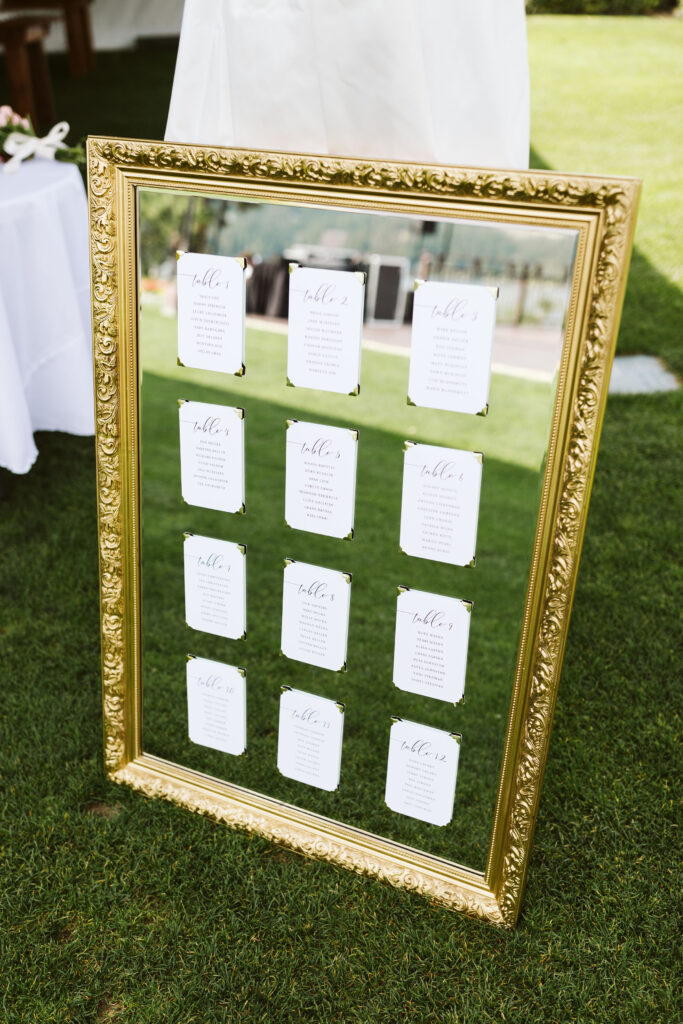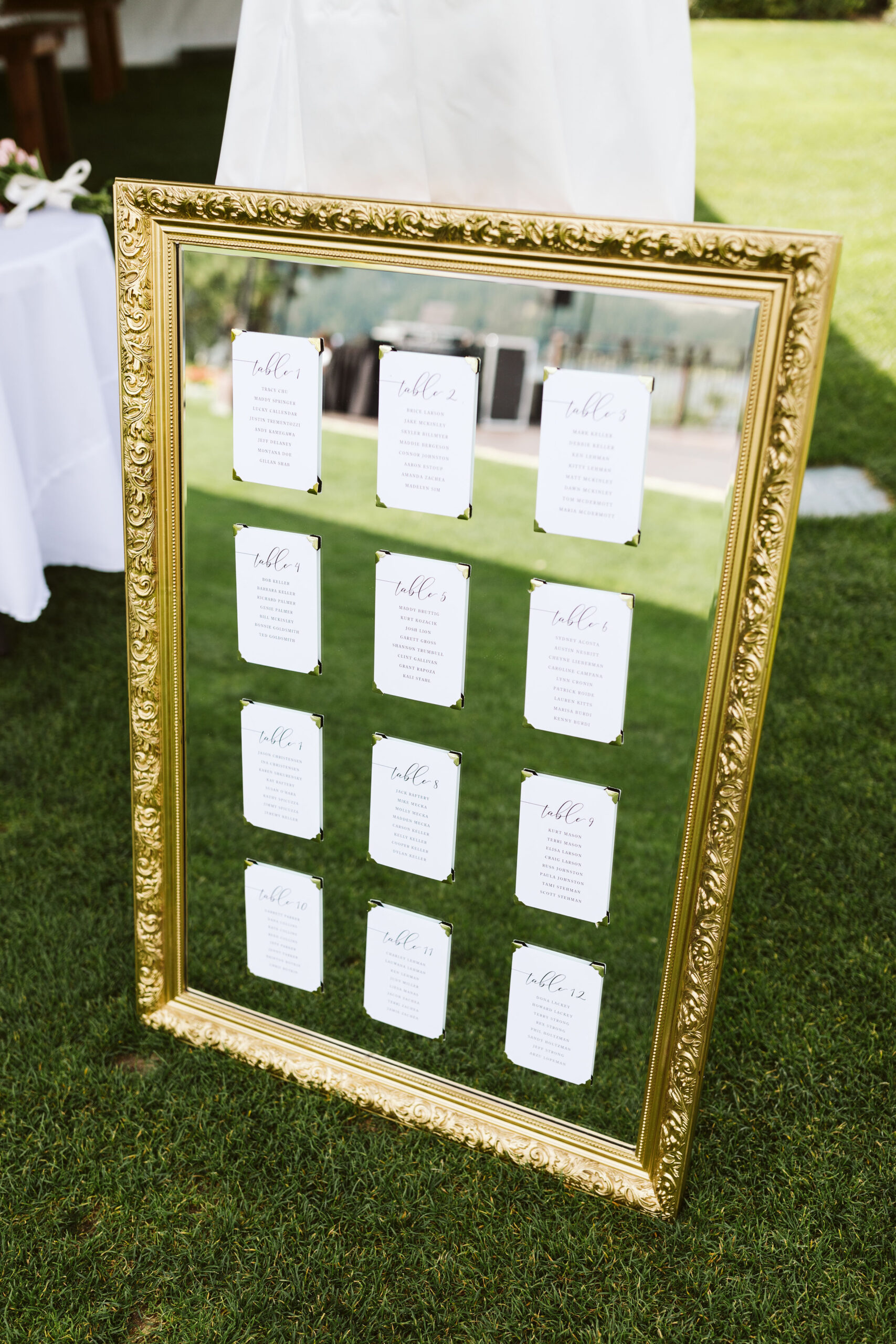get the downloadables
I'm Sydney
To have a seating chart or to not having a seating chart… one of the most common questions I seem to get asked. First of all, there is never a ‘right’ answer to this question. It all comes down to preference, vision and what is going to make YOU less stressed out. I hear all kinds of reasons why couples are waffling whether or not to have a seating chart… “My Uncle Bob and Uncle Joe had a big fight last Christmas and now they can’t even be in the same room together, I don’t want there to be a fight at my wedding,” “I have a blended family and it has always been easier to keep everything separate,” “I have a really big family and they are all going to expect to be at a ‘reserved’ family table, so I might as well just do a seating chart for everyone so they feel included.” These are all valid reasons to incorporate a seating chart into your décor, but one reason I don’t like to hear is, “I see so many other weddings doing it now that I figured it was something we had to do.” Every decision you make for your wedding should not be based on what someone else did at their wedding, but instead it should be something you want to do because it fits in with your wedding vision.
However, the reason I get asked this question is because the couple genuinely wants to know my opinion and wants to make sure that their wedding runs as smoothly as it possibly can, so I usually start my answer with, “Well, there are pros and cons…” Three nice things about a seating chart are:
1. It allows you to take control of the different dynamics and sit your family and friends where you want them to sit.
2. It takes away the unknown for the guests who often say, “I don’t know where to sit” or the constant, “Are these seats taken?” – especially if they don’t know anyone else there except the bride and groom.
3. It adds and elegant touch and décor element. A seating chart can be created out of all kinds of different things, a chalkboard, door, mirror, pallet, etc. Just another reason to get creative.
On the flip side, here are 3 reasons why some couples prefer to not have a seating chart:
1. Added stress… there are so many different friend and family dynamics to think about and it may be very difficult to seat people together who all get along. There is also the stress of dealing with the last-minute cancelations and having to rearrange a seating chart you have already spend hours on.
2. People are going to sit where they are going to sit. I always tell brides, specifically, to keep their expectations realistic… if someone doesn’t like where you placed them, there isn’t a bodyguard there telling them they can’t move, most likely they are going to do it anyways and rearrange the seating chart for you because often times people want to sit by people they feel most comfortable with.
3. Couples often want to convey a laid-back feel, so they may reserve a table or two for immediate family but have open seating throughout the rest of the reception space allowing guests to sit where they want. I see this happen also if the bride and groom received a lot of ‘maybes’ or ‘I’m really going to try to make it, but I am not 100%’ from their guests, so it is easier not to assign seats, but just make sure they have enough seats for everyone.
Once a couple decides they do want to include a seating chart for their reception, sometimes they will ask me what the difference is between using a master seating chart and just using place cards and if one method is preferred over the other. Again, there are no wrong answers here, but instead how much detail you want to put into where people are sitting to eat their free-to-them meal. A seating chart, like the wood one pictured below, is just that… something telling your guests what table they are sitting at then once they get to said table, they choose which seat to sit in. The wedding where the mirror seating chart, pictured below, was incorporated also had place cards on the other end telling the guests where to sit once they reach their assigned table. This was not something that was necessary as the couple chose to have a buffet for their dinner, so I was not concerned what each guest was having for dinner. If the couple chose to have a choice plated meal for dinner the place setting would have become a must, but not necessarily the seating chart. If you want to have a choice plated meal, but you don’t want to have both a seating chart and place cards at every setting, there are such things as escort cards that will alleviate some of that work – I know, so many different vocab words, but stay with me here. An escort card is just that, a card with the guest’s name and table number on it that will, in a way, escort them to their table. If it is necessary for the meal, this is where you would also put what they are having for dinner, so they can place the card in front of them at their table (after they have chosen their seat), clearly identifying for the wait staff which entrée to serve them.
A seating chart (whichever form you choose) can be a nice personal touch to a wedding, but unless it is needed for the meal, don’t let anyone tell you it is a necessity. If you don’t need it, but it is something you still want to incorporate because of your vision and style that is awesome and clearly, they make for great detail photos! No matter what you decide when it comes to a seating chart, I always tell couples not to go overboard (or get too picky), keep your expectations realistic and most importantly don’t stress yourself out more than you already are – weddings are stressful enough!

If you found this article helpful and want to chat further, head on over to the services page for my packages and pricing information. If you have any questions, feel free to contact me or leave a comment below!
#weddingplanner #apieceofharmonyevents #northidahoweddingplanner #spokaneweddingplanner #idahowedding #pnwwedding #seatingchartdebate #weddingseatingcharts #weddingblog #theknot #weddingwire
You Might Also Love...
Leave a Reply Cancel reply
Our monthly newsletter is a great way to stay up-to-date on all the happenings in the wedding community, get links to the most recent blog posts, and be the first to know when any new digital resources are released!
stay up to date.
From the beginning stages of creating a budget to comparing venues and all the way through keeping all your vendor contact information in one place.
